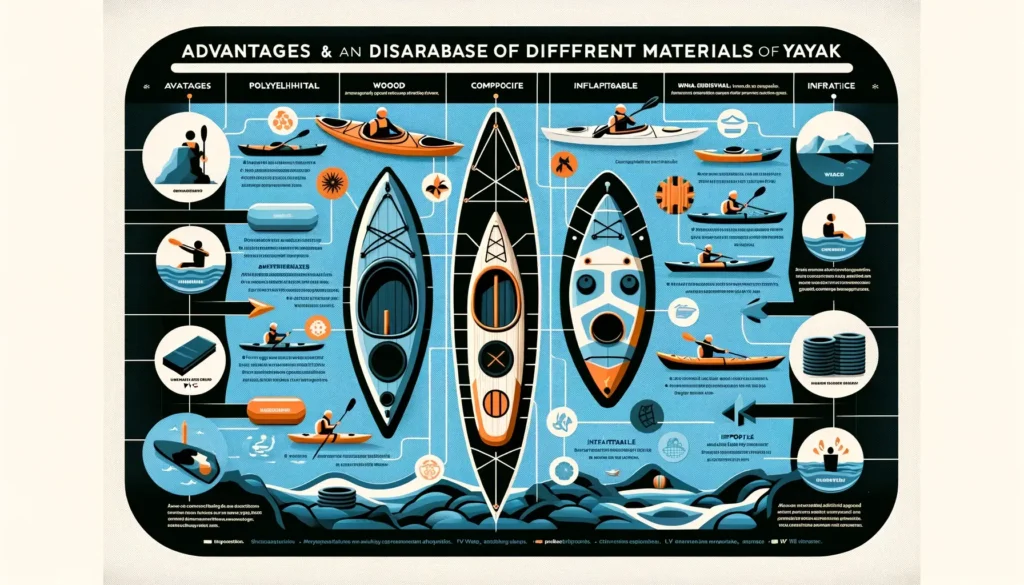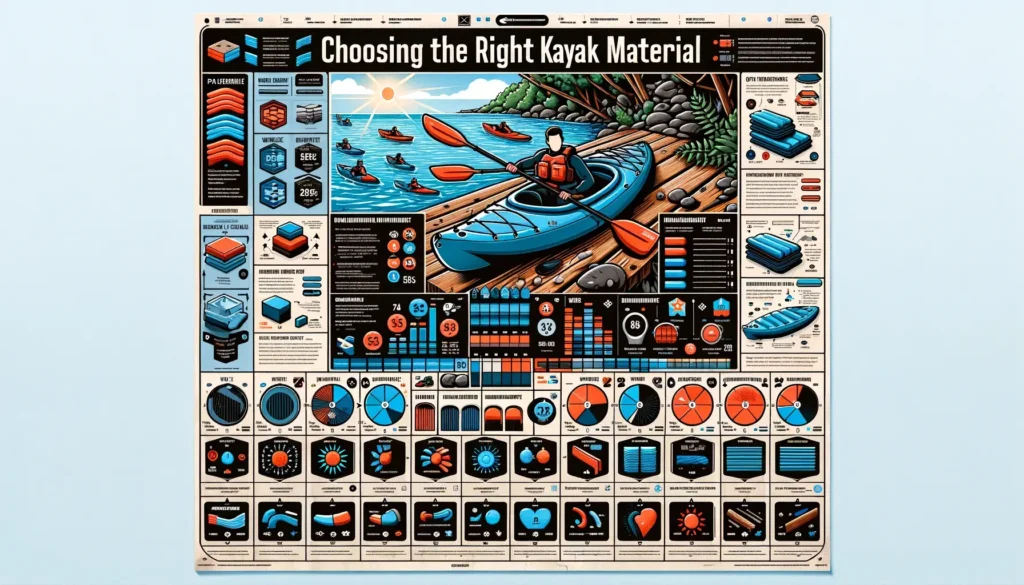Kayaks are typically made out of materials such as polyethylene, fiberglass, or carbon-fiber composite. Kayaks are popular watercrafts used for recreational purposes and various water activities.
They range in design and size, but what they are made out of plays a significant role in their performance on the water. Common materials used to construct kayaks include polyethylene, fiberglass, and carbon-fiber composite. Polyethylene is a durable and cost-effective option, while fiberglass offers a lightweight and responsive experience.
Carbon-fiber composite provides the greatest strength-to-weight ratio, making it ideal for high-performance kayaks. Each material has its own advantages, but all are designed to withstand the rigors of paddling and ensure a safe and enjoyable experience on the water. Whether you’re a casual paddler or an experienced adventurer, choosing the right kayak material is essential for maximizing your time on the water.
Traditional Materials
Traditional materials have been used for centuries in the construction of kayaks. These materials are not only durable and functional but also provide a unique aesthetic appeal to these small watercraft.
Wood
Wood is one of the oldest materials used in kayak construction. It offers a lightweight yet sturdy option for building kayaks, providing excellent maneuverability on the water.
Animal Skins
Animal skins have historically been utilized in kayak construction by indigenous peoples in Arctic regions. Sealskin and walrus hide are common materials that offer waterproof and flexible properties for kayaks.
Modern Materials
Rotomolded Plastic
Kayaks made from rotomolded plastic are durable and affordable, perfect for beginners.
Fiberglass
Fiberglass kayaks combine strength and flexibility, ideal for intermediate paddlers seeking performance.
Kevlar
Lightweight and strong, Kevlar kayaks are popular among advanced kayakers for their speed and durability.
Carbon Fiber
Carbon fiber kayaks offer top-tier performance, prized by elite paddlers for their lightness and rigidity.
Advantages And Disadvantages Of Different Materials

Deciphering the suitability of various materials for crafting kayaks reveals distinct advantages and drawbacks. Fiberglass offers durability and stiffness but can be heavy, while plastic kayaks are affordable and low-maintenance but lack in performance compared to composite kayaks, which strike a balance between weight and strength.
When it comes to kayaks, there are several different materials used in their construction. Each material offers its own set of advantages and disadvantages, which can greatly impact the kayak’s durability, weight, and performance.
Durability
One of the key factors to consider when choosing a kayak material is durability. The durability of a kayak determines its ability to withstand the rigors of the water and how long it will last.
Here are some common kayak materials and their durability:
| Material | Advantages | Disadvantages |
|---|---|---|
|
|
|
|
|
|
|
|
|
|
|
|
Weight
The weight of a kayak can greatly impact its maneuverability and ease of transportation. Here’s an overview of the different kayak materials and their weight characteristics:
- Fiberglass: Relatively heavy, making it more difficult to transport but offering stability on the water.
- Plastic: Heavier compared to other materials but provides durability and affordability.
- Kevlar: Lightweight material that enhances the kayak’s performance but comes with a higher price tag.
- Carbon Fiber: The lightest material, perfect for those seeking speed and agility, but comes at a higher cost.
Performance
Finally, the choice of kayak material can significantly impact its overall performance on the water. Different materials have varying characteristics that affect how the kayak moves through the water and handles different conditions.
Here’s a breakdown of the performance advantages and disadvantages of various kayak materials:
- Fiberglass: Offers good tracking and stability, but is more susceptible to damage from rocks or rough terrain.
- Plastic: Provides excellent initial stability but may lack in speed and maneuverability.
- Kevlar: Enhances overall speed and agility, making it ideal for racing or touring.
- Carbon Fiber: Delivers exceptional performance in terms of speed and responsiveness, but requires careful handling to avoid damage.
Choosing The Right Kayak Material

When it comes to choosing the right kayak material, there are several factors to consider. The material of a kayak affects its performance, durability, and price. Understanding the different kayak materials available and how they align with your skill level, intended usage, and budget is crucial in making the right choice.
Skill Level
Choosing the right kayak material depends on your skill level. Beginners may prefer more durable and forgiving materials, while advanced paddlers might prioritize lightweight and high-performance options.
Intended Usage
Your intended usage dictates the ideal kayak material for you. For calm waters and recreational use, rotomolded polyethylene kayaks are an affordable and durable choice. Alternatively, composite kayaks are better suited for advanced paddlers or those planning to tackle rougher waters.
Price Range
The price range of kayak materials varies widely. Rotomolded polyethylene kayaks are typically the most budget-friendly, while composite and thermoformed kayaks are more expensive, but offer superior performance and durability.
Environmental Impact Of Kayak Materials
Kayaks are popular watercraft used for recreational and competitive sporting activities. They can be made from a variety of materials, each with its environmental impact. Understanding the sustainability and recyclability of kayak materials is crucial in making eco-conscious decisions when purchasing a kayak.
Sustainability
When it comes to the sustainability of kayak materials, natural and renewable resources like wood and bamboo are the most environmentally friendly options. These materials have a lower carbon footprint and can be sustainably sourced, making them ideal for eco-conscious kayakers. Additionally, some companies are also exploring the use of recycled plastics in kayak production, further contributing to sustainability efforts.
Recycling
Kayak materials vary in their recyclability. Plastic kayaks, for example, can be difficult to recycle due to the complex nature of plastic polymers. However, some manufacturers are committed to creating recycling programs for end-of-life kayaks, allowing the materials to be repurposed rather than ending up in landfills. On the other hand, wooden kayaks have the potential to be easily repurposed or recycled, adding to their eco-friendly appeal.
Maintenance And Care
Maintaining and caring for your kayak properly is essential to ensure its longevity and optimum performance. By following a few simple steps, you can keep your kayak in great condition for years to come.
Cleaning And Storage
Regular cleaning after each use will help prevent dirt, grime, and saltwater buildup on your kayak. It’s crucial to rinse off your kayak with fresh water and use a mild detergent or kayak cleaner to gently scrub away any stubborn stains or debris. Be sure to clean both the interior and exterior surfaces of your kayak, paying extra attention to crevices and hard-to-reach areas.
When it comes to storage, finding a suitable location is key. Ideally, your kayak should be kept in a dry, shaded area away from direct sunlight and extreme temperatures. If storing your kayak outside, use a protective cover to shield it from the elements. It’s also a good idea to store your kayak off the ground to prevent unwanted critters from making it their home.
Repairing Kayaks
Inevitably, your kayak may experience wear and tear over time. It’s important to address any damages promptly to maintain its integrity. For minor scratches or scuffs, you can use a kayak repair kit to touch up the affected areas. Simply follow the manufacturer’s instructions to ensure proper application.
However, if your kayak sustains more significant damage, such as cracks or holes, it’s recommended to seek professional assistance. Kayak repair experts have the necessary skills and expertise to perform structural repairs and ensure your kayak remains safe and functional.
Remember, regular inspection and maintenance are crucial to ensure your kayak remains in top condition. By following these steps, you’ll be able to enjoy countless adventures on the water with your reliable and well-maintained kayak.
Frequently Asked Questions On What Are Kayaks Made Out Of
What Are The Different Materials Used To Make Kayaks?
Kayaks are commonly made from materials such as fiberglass, plastic, wood, and inflatable PVC. Each material has its own strengths and weaknesses in terms of weight, durability, and cost.
Are Kayaks Made From Plastic Durable For Water Activities?
Plastic kayaks are popular for their durability and resilience to rough waters, making them suitable for recreational and fishing purposes. However, they can be heavier compared to other materials.
Can Kayaks Made From Fiberglass Withstand Rocky Waters?
Fiberglass kayaks are known for their lightweight construction and high performance in various water conditions, including rocky waters. They’re durable, but might require occasional maintenance for minor damages.
Conclusion
Kayaks are versatile and widely used watercraft made from durable materials like polyethylene, fiberglass, and wood. These materials provide a strong and lightweight structure, ensuring a smooth and safe paddling experience. Understanding the construction of kayaks helps paddlers make informed decisions when selecting the right type of kayak for their needs.
So, whether you’re a casual paddler or an adventurous adventurer, knowing what kayaks are made out of is essential for enhancing your water sports journey.
